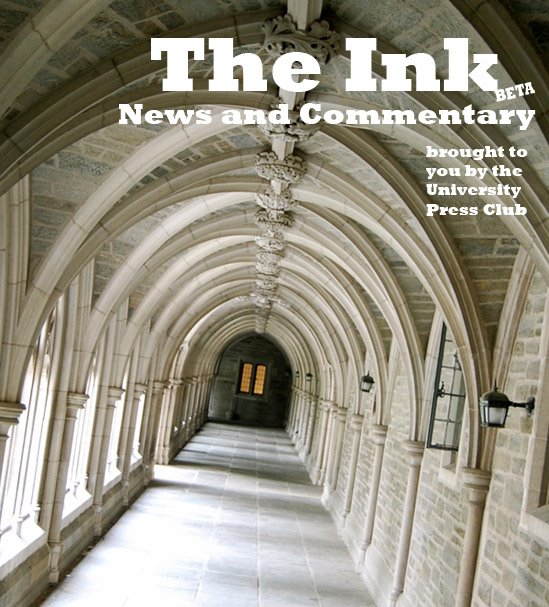Up until about two months ago, Princeton University was blessed by a very large endowment, which allowed the school to purchase an impressive quantity of outdoor sculptures by well-known artists. Unfortunately for the would-be audience of these pieces of art, there appears to be an inverse correlation between the price and/or importance of a sculpture and its artistic accessibility. Here at Drink the Ink, we’re going to try to unravel the mystery of two of Princeton’s more unique works:
 The first stop on our tour of campus sculptures falls between Firestone Library and the Chapel. To a quickly passing observer, the statue likely appears graphically sexual; there seems to be one man, on his knees, with his head positioned suggestively near the other man’s private region. Why, one wonders, is this sculpture on campus, next to the chapel no less? Is it a statement on discomfort with homosexuality? Is it a critique of the desensitization of sex in modern culture? The man's hands appear bound - is it some strange advertisement for light bondage?
The first stop on our tour of campus sculptures falls between Firestone Library and the Chapel. To a quickly passing observer, the statue likely appears graphically sexual; there seems to be one man, on his knees, with his head positioned suggestively near the other man’s private region. Why, one wonders, is this sculpture on campus, next to the chapel no less? Is it a statement on discomfort with homosexuality? Is it a critique of the desensitization of sex in modern culture? The man's hands appear bound - is it some strange advertisement for light bondage?More...
But a closer look at the statue, and its history, proves that these initial queries could not be farther from the truth.

The statue’s actual name is "Abraham and Isaac: In Memory of May 4, 1970, Kent State University". Kent State commissioned artist George Segal to create a sculpture following the shooting of Vietnam War protesters by the National Guard. In 1979, after Kent State rejected the sculpture, asking for a more literal interpretation, Princeton purchased the sculpture and installed it in its current resting place. The result: a very strange schism between a somber, reflective piece of art and its somewhat juvenile, if understandable, perception on campus.
Fun Fact to Know and Share: Segal was a local artist, living on a chicken farm in South Brunswick, New Jersey, until his death in 2000.

One of the other statues on campus that both draws attention and defies easy explanation is the strange green donut located to the right of Nassau Hall. What’s odd about this statue is how different it looks from each angle. Drink the Ink thought it had solved the mystery when a passerby noticed our curiosity and told us the statue was called “Nixon’s Nose,” bringing us around to an angle at which the statue did indeed resemble the nose of the 37th President. But there was more to this sculpture than that.

VS

The real name of this sculpture is the decidedly less creative "Oval with Points" by acclaimed British artist Sir Henry Moore. And despite the remarkable resemblance to Nixon’s Nose, and the fact that Nixon was indeed in office when the sculpture was installed in 1971, it seems that Moore’s actual inspiration for the piece was an elephant skull his wife and a friend brought back from Africa.

Side Note: We’re not sure if this actually makes Oval with Points any less weird or just sort of explains the methodology behind the weirdness.
Now, we’re sure you’re wondering: what do these two statues have to do with an Army Air Force Pilot shot down during World War II? EVERYTHING! It turns out both these two sculptures, and many of the other artistic oddities around campus, are at Princeton because of the Putnam Collection - someone anonymously donated one million dollars in honor of Lt. John Putnam in order to have famous sculptures on campus.
And now you have a little relief from that mild burning sensation somewhere in the question part of your brain. Don’t thank us: this is why we’re here.
-SKG




1 comment:
Many thanks for easing my confusion re the Segal sculpture. Depending on the angle from which one approaches it, the statues may indeed look...unusual. My friends and I couldn't find a plaque, so it's wonderful to discover this explanation.
Post a Comment